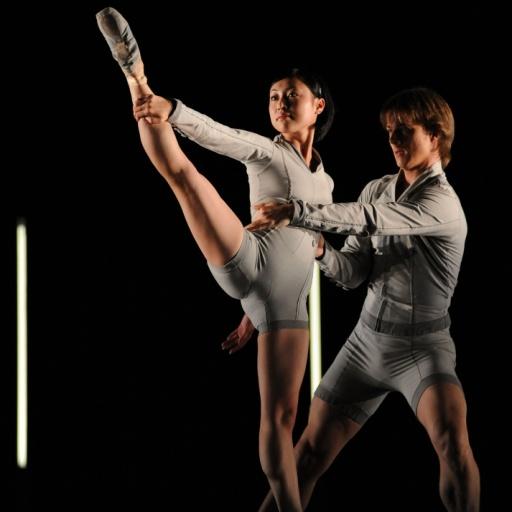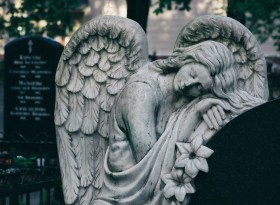Six works were programmed, four of which were presented on opening night: Jiri Kylian’s exquisite Un Ballo, two new works by young choreographers, and the Australian premiere of Garry Stewart’s The Centre and its Opposite. This proved to be excellent programming. The new works were experimental, but bracketed between the more mature pieces they served to remind us that experimentation is the soul of modern dance, while the bracketing pieces quietly demonstrated where we have come from and where we are now.
Un Ballo, with music by Ravel and costumes by Joke Visser, is an excellent example of Jiri Kylian’s lyrical yet adventurous work. Kilian’s choreography needs no introduction. His legendary work with the Nederlands Dans Theatre has ensured him a pre-eminent place among choreographers of the late 20th century. Kylian’s dance composition shows influences from the previous generation, notably, perhaps, George Balanchine in his lyricism and use of shape and Agnes de Mille in his use of angular, anti-classical moves and poses, and incorporation of folkloric elements. Thus Kylian provides a strong link in a chain that reaches back to the Renaissance, through the Romantic Movement and the heady days of the Ballet Russe to the upsurge of modern dance during the last century.
This production demonstrated the company’s strong unison work to a sometimes difficult score, while giving several soloists chances to shine. All seven couples acquitted themselves admirably, but perhaps special mention should be made of audience favourites Jane Smeulders and David Mack.
The second offering of the evening, Glam Addict, was choreographed by company member William John Banks, a locally born and trained talent who is enjoying a career that’s not quite meteoric but is certainly rapid in its progress. The youngest of the four choreographers represented in the Neon Lights season, Banks has been with the WA Ballet less than two years, having graduated from WAAPA in 2009. Glam Addict is his first professional work, in which he acknowledges his debt to pop culture icons such as Lady Gaga and Madonna. While still showing some of the hallmarks of student choreography in its gimickiness, the work is quirkily interesting, and thought-provoking in that it gives hints of the kind of thing that happens to us when we allow ourselves to become slaves to anything. At what point does passion become addiction? Banks’ work seems to suggest that the line must be drawn somewhat short of allowing ourselves to be turned into automata.
Banks was the only choreographer in the program to participate in his own creation as a performer, and his partnership with Andre Santos resulted in a seamless presentation. He chose music by Perth based electronic band The Substance, while the eccentric and highly suitable costumes were by Gautam Kapoor.
The third piece was another world premiere, created by Reed Luplau, an ex-Sydney Dance Company member and protégé of no less a mentor than Graeme Murphy himself. Luplau was a quarter-finalist in Superstars of Dance, 2009 and an Australian Dance Awards winner in the same year, taking out Best Solo by a male performer.
In The Sixth Borough, Luplau explores the idea of a city within a city, a theme that’s been revisited over and over again in the arts, most especially, perhaps, in literature. As Wikipedia says of China Mièville’s novel The City and the City, “a denizen of one city must dutifully ‘unsee’ (that is, consciously erase from their mind or fade into the background) the denizens, buildings, and events taking place in the other city — even if they are an inch away”. Sadly this can be interpreted as a metaphor for our unseeing of people who lead a different lifestyle from our own. In Luplau’s dance work, these people come to life after dark, inhabiting a warehouse-like building where they live and relate to each other when we – the inhabitants of the “other” city, are not around.
Highly acrobatic moves required well-finessed timing as well as supreme fitness and, I suspect, a willingness to ignore the fact that the floor is hard and a long way down. The use of seven dancers – three women and four men – meant that the work never fell into the sameness that a series of duets can bring. Instead, couples, trios and larger groups met and parted, interacted and ignored each other, participated and looked on – just as we do the “real world”.
Luplau’s clever use of supported revoltades and cartwheels become the piece’s signature moves, turning up over and over again in different contexts and formats. Music by Maroon 5, Daft Punk, Scanner, Ljova and the Contraband, and Rodrigo y Gabriella were cleverly melded into a seamless score that was always appropriate and never intrusive. Laplau himself designed the costumes, which provided an integral part of the movement.
The final presentation of the evening, The Centre and its Opposite, utilised the talents of almost the entire company. Like the opening work, Un Ballo, Centre showed us where modern dance is today, paying homage to earlier choreographers while still branching out in new directions. Choreographer Garry Stewart devised this piece for the Birmingham Royal Ballet, and this performance was its Australian premiere.
In an interview at the time of the BRB production, Stewart explained that he was looking at the stage as a site of power relationships and that he was also exploring the relationship of performers to the audience. The centre of the stage is the most powerful spot, but here the dancers use different areas of the stage to gain the audience’s attention, often in competition with each other, so there is some suggestion of territoriality as well. This made for some very busy choreography. There was very little centring going on, but a lot of movement – much of which, appropriately enough, was based on the centre practice component of the standard ballet class.
I must admit to being a tad disappointed in Centre – it is not a short work and what it had to say could have been said in half the time. Knowing only the enigmatic title, I was hoping for something more meaningful – something bearing reference, perhaps, to the well-known quote from John Donne: “Man is but earth, ‘tis true, but earth is the centre. The man who dwells upon himself, who is always conversant in himself, rests in his own true centre” – as good a recipe for personal growth and centring as might be found in any psychological system. But I was left with no idea of what the “opposite” of the title referred to in either literal or figurative senses. Personal disappointment aside, however, The Centre and its Opposite is enjoyable, well-served by Huey Benjamin’s music and the costumes by Georg Meyer-Wiel.
Mention must be made of the unique lighting in this production: Neon Lights lives up to its name in this regard. Fluorescent tubes played a large part. In Un Ballo, for example, whose lighting design was by J. Caboort and K Tjebbes, they were suspended on a staged grid over the acting area, reminiscent of the rows of votive candles one sees in side chapels of big cathedrals, while in The Centre and its Opposite larger tubes were placed on either side of the proscenium as well as on the grid, which was lowered at one point until it almost touched the supine dancers on the stage floor. The company’s technical director, Jon Buswell, realised these lighting designs as well as being responsible for the very suitable designs of the two middle pieces. The company is fortunate gaining the services of such an experienced and talented lighting tech. Buswell has previously worked for the Australian Ballet and Chichester Festival Theatre.
The WA Ballet’s next production will be The Taming of the Shrew with Cranko’s choreography, which will play at Her Majesty’s Theatre, Perth, September 9 – 24. I’m counting the weeks already!
The West Australian Ballet presents
Neon Lights
Artistic Director Ivan Cavallari
Ballet Mistress: Eva Zmekova
Ballet Master: Craig Lord-Sole
Technical Director: Jon Buswell
Wardrobe Manager: Sara Walker
Stage Manager: Deborah Whiteley
Cast includes Fiona Evans, Benjamin Marett, Sergey Pevnev, Jayne Smeulders, Yu Takayama, David Mack, William Banks and Andre Santos
State Theatre Centre of WA
July 23-30






